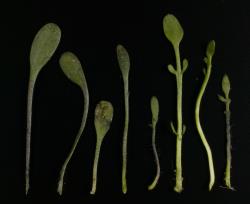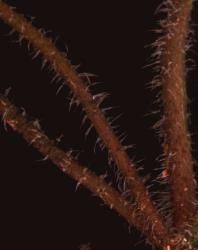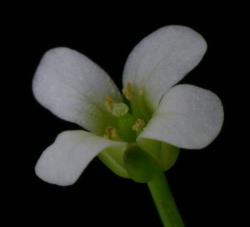Small perennial herb, single rosette or with short lateral branches, stem and branches 0.5–0.6 mm diam. Leaves up to 25(–45) mm long, seedling leaves simple, mature leaves pinnatafid or pinnatisect; lamina 5.0–12.0 × 2.0–3.0 mm, green to brown-green, usually slightly coriaceous, glabrous on abaxial and adaxial surfaces. Terminal pinna 2.0–8.0 × 0.5–5.0 mm, usually simple, sometimes with 1–2 irregular lobes, elliptic, broadly elliptic, obovate, ovate or spathulate, apex obtuse with a prominent hydathode, base attenuate to cuneate. Lateral pinnae 0–6, 1.0–2.2 × 0.2–0.7, elliptic, oblong, ovate or obovate, usually glabrous although margin of lower pinnae sometimes sparsely hairy, hairs septate and 0.3–0.4 mm long; petiole up to 20(–25) mm long, glabrous or sparsely hairy on margin, hairs septate and 0.3–0.5 mm long. Cauline leaves occasional, similar to rosette leaves but smaller and with fewer lateral pinnae. Inflorescence corymbose, 2–8-flowered, flowers sometimes solitary; peduncle up to 30 mm long, c. 0.3 mm diam. At base, spreading to ascending, glabrous to moderately hairy. Pedicels up to 37 mm long, 0.2–0.5 mm diam., terete, flexuose, glabrous to sparsely hairy. Sepals 0.9–2.0 × 0.5–1.1 mm, elliptic-oblong to broadly elliptic, saccate, green or red-brown, glabrous, margin white and membranous, apex obtuse, base truncate. Petals (1.0–)2.0–4.0(–5.2) × 1.2–2.0 mm, white, limb obovate to broadly elliptic, occasionally apetalous; apex obtuse; base cuneate, tapering to a c. 1 mm-long claw. Stamens 6, ± similar length; filaments 0.3–2.4 mm long; anthers 0.3–0.6 mm long, cream to pale yellow, when dehiscent held at a similar height to or slightly below the stigma. Ovary 0.9–2.8 mm long, 0.3–0.4 mm diam., ± terete, green, glabrous; ovules 8–14; style c. 0.2 mm long, ± terete; stigma 0.2–0.3 mm diam. Siliques 6.0–11.0 × 0.6–0.9 mm, glabrous, style indistinct; valves green to red-brown at maturity; straw-coloured when dehiscent, replum 0.3–0.4 mm wide. Seeds 0.5–0.9 mm long, 0.3–0.5 mm wide, 0.2–0.3 mm thick, orbicular to orbicular-oblong, yellow-brown to henna; wing absent.
Cardamine mutabilis is distinguished from the larger and more robust C. glara by its diminutive growth habit, leaves up to 45 mm long, narrower terminal leaflet, smaller sepals, petals and filaments, and shorter siliques.
North Island: Volcanic Plateau.
South Island: Marlborough, Canterbury, Otago.
Cardamine mutabilis is known in the South Island from south-eastern Nelson, Canterbury, and Otago, and in the North Island from a single collection from upper Mākatote River, Mt Ruapehu (northern Wellington).
Cardamine mutabilis usually occurs on the periodically inundated turfy margins of montane and inland tarns and lakes, and also in wetlands associated with the banks and edges of streams. When associated with tarn and lake margins it occupies the marginal turf zone as water retreats and the margin dries out. It has also been collected from wet ground in tussock-grassland and herbfields.
Cardamine mutabilis is assessed as having a conservation status of Threatened—Nationally Critical (A3), with the qualifiers Conservation Dependent, Extreme Fluctuations, Data Poor, Range Restricted and Sparse (de Lange et al. 2018). The qualifier Conservation Dependent is applied because at some sites (e.g., Sedgemere Tarns, Marlborough) intensive management is required for weed control and to ensure the survival of indigenous plants (Heenan 2017). The qualifier Extreme Fluctuations is used because the lake and tarn margin habitat is dependent on fluctuations in water level for suitable habitat, and Data Poor because the population numbers and trends are not known with certainty.
Flowering December–March; Fruiting December–April.
Chromosome number 2n = 48 (CHR 546262).
The sizes of the floral and vegetative parts of C. mutabilis are variable depending on growth conditions and age of the plant (Heenan 2017). Plants from moist sites, for example, are generally much larger in all parts than plants from drier sites. A number of floral characters are particularly variable in this regard, with some very small plants with leaves 10–20 mm long having petals 1.0–1.5 mm long (e.g., CHR 312947), whereas other larger plants (with leaves up to 30 mm long) have petals up to 5 mm long (e.g., CHR 420058). Typically, the petals are 2–4 mm long. Other floral characters show a similar range of variation in size. The leaves are also variable, with the leaves on mature plants being pinnatifid or pinnatisect and those of seedlings (e.g., CHR 546262) and some plants from moist habitats (e.g., CHR 21016) being unifoliate.
Previously known by the tagname C. “tarn” (e.g., de Lange et al. 2013, p. 65).









